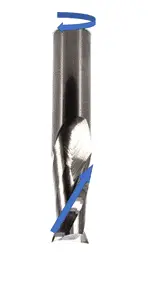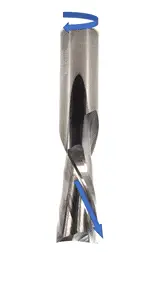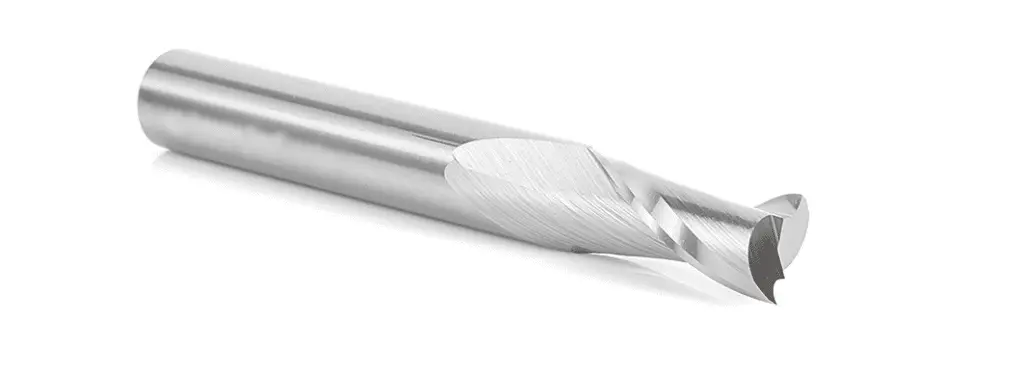I used to use only straight cut router bits for years. For a long time, they were what came in the cheap bit packages I used to buy all the time. After stepping away from woodworking to focus on a career for a while, I was happy to find those spiral bits had become not only plentiful but very affordable. Well, maybe my perspective of affordable had changed a little thanks to a successful career.
Up-cut router bits are characterized by spiraling blades that will clear out the chips from the work area by pulling them toward the motor of the router. These blades tend to be in contact with the workpiece through each revolution and will create a much smoother cut compared to a straight bit.
An up-cut router bit is one of 3 basic spiral configurations found in common woodworking shops that cut a flat edge. All spiral router bits can produce a better cut with smoother results and less chatter when compared to straight cut router bits. While up-cut router bits can be effective for deep plunge cuts – as in a mortise – They can also perform very well when you cut dados, rabbets, grooves, trenches, or channels.

Up-Cut Bit 
Down-Cut Bit 
Compression Bit
Of the three types of spiral bits; Up-cut, Down-cut, and Compression, the up-cut is probably the most used. Since it can clean out the chips as it cuts, the up-cut bit generates less heat and produces fewer burn marks than the other two that tend to pack the chips into the cut. This is not true, however, if the cut is cutting the entire thickness of the material. This feature is very useful for deep, narrow cuts such as a mortise.
On a CNC, an up-cut router bit can tend to pull the workpiece up off the table. Extra effort to hold the workpiece to the table will make for a happy day. Compared to a handheld router where the base plate is directly attached to the motor and will hold the workpiece in place.
Slicing Action
Up-cut bits will pull the wood toward the motor – no matter the orientation of the router. While mounted in a table, the motor is mounted under the table, so the bit is cutting motion is actually “down” in relation to gravity. This pulls the workpiece to the table and will help stabilize the router and reduce vibration.
When used in a hand held router, the cutting action will pull the workpiece up into the router base. The same effect of stabilizing the router and workpiece is obtained.
When using an up-cut bit, you should know that the edge of the workpiece that is closest to the motor will experience some lifting or tear-out. This is most evident on laminated material such as plywood but can also be seen on hard, brittle woods. Often, a piece of painters tape placed over the cut line will help eliminate this problem or possibly eliminate it.
The spiral shape of the flutes will also create a continuous slicing motion and tends to prevent chipping when cutting highly figured wood. With at least one cutting edge in contact with the workpiece, chatter and vibration are greatly reduced. All flutes (Blades) will have constant contact with the material that you are cutting. As the blades go swirling into the material, they will produce a slicing action rather than a chopping action created by the straight blade bit
Plunge Better than Straight Bits
The flat end of an up-cut spiral bit is made to plunge straight into wood and other softer materials. The cutting edges continue from the cutting edges around and onto the tip of the bit. The geometry of these cutting edges effectively removes the material as the bit plunges into the workpiece.

While this article has dealt mostly with flat bottom bits, everything covered here also applies to the other tip typed that comes with spiral cutting edges. Some of these choices are Ball Nose bits, Tapered Bits (created a tapered edge rather than a flat edge), and Chip Breaker bits.
Because up-cut router bits can plunge cut, they are popular with the CNC router crowd. They can be used to rough out material quickly and to cut out the final profile of any work done on the CNC. they leave a smooth edge that will require only a little sanding.
In conclusion, up-cut router bits are very versatile and can be used in handheld routers as well as router tables and CNC router machines. Up-cut bits will eject the chips toward the motor and will draw the workpiece into the router table or router base but will tend to pull the workpiece off of a CNC Router table if not properly secured.

